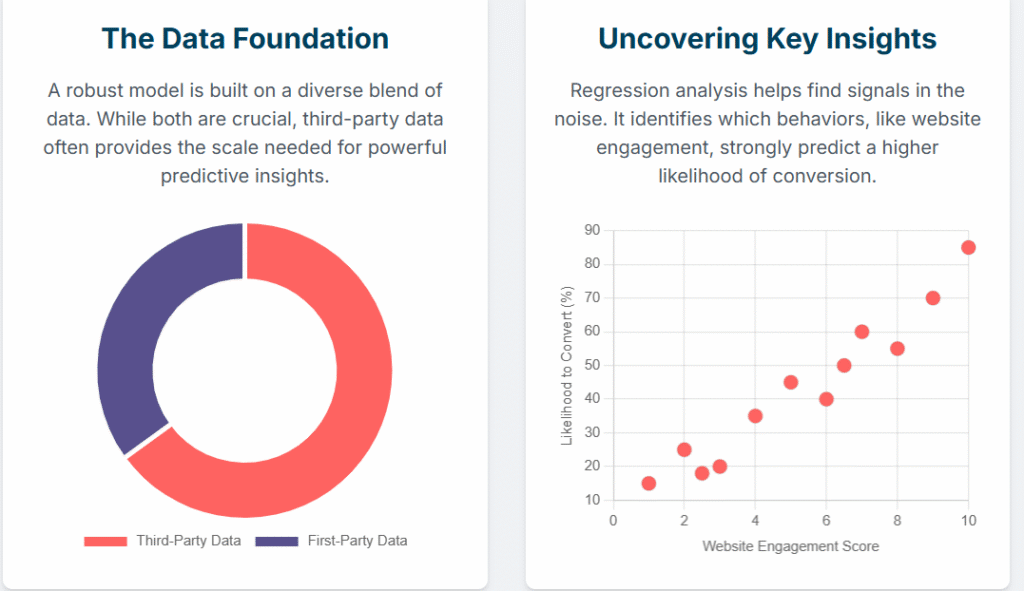In today’s competitive landscape, guiding a potential customer along the most optimal buying journey is paramount to success. This isn’t about guesswork; it’s about using data to make intelligent decisions. At the heart of this data-driven approach lies real-time lead scoring—a sophisticated engine that integrates seamlessly into your sales process to maximize conversion rates and optimize resources.
By combining both first-party and third-party data assets, a robust lead-scoring model empowers your team to understand a lead’s potential and determine the most effective way to engage with them at every stage of their journey. This isn’t a one-time score; it’s a dynamic system that continuously re-evaluates and refines its guidance as new information becomes available.
Seamless Integration is Key
For lead scoring to be truly effective, it must be more than just a number—it must be a fundamental part of your operational ecosystem. The primary integration point is your Customer Relationship Management (CRM) system. When a lead’s score is immediately available within the CRM, it can power a decision tree that guides your sales team. This provides a clear, data-backed path for navigating the prospect’s journey.
But the power of lead scoring extends far beyond the CRM. Its integration can also influence:
- Lead Assignment: Automatically assign high-scoring leads to your top-performing sales representatives or route them to specialized teams (e.g., inside vs. outside sales).
- Marketing Cadences: Tailor email campaigns and content to match a lead’s score and stage, ensuring your messaging is always relevant and timely.
- Cost of Acquisition (CAC) Metrics: By focusing on the most promising leads, you can reduce the overall effort required to close a sale, directly impacting your CAC.
Building a Predictive Lead Scoring Model
A powerful lead-scoring model is built on a foundation of data and advanced analytics. The process begins by analyzing two core audiences: your past customers who have converted, and a random control group. Using multi-variate regression modeling, you can identify the data elements and their specific values that are most predictive of a successful conversion.
The best models leverage a mix of data sources:
- Third-Party Data: This includes demographic, behavioral, and econometric data. Do leads in a specific industry or with a certain job title convert at a higher rate? Do they show specific online behaviors or macroeconomic indicators? This data helps you identify valuable “look-alike” customers.
- First-Party Data: This is the information you’ve gathered directly. Think about the lead’s source, their interactions with your website, which digital ads they’ve seen, and their direct engagement with your content or team. This data provides a crucial feedback loop, allowing the model to re-score prospects in real-time as they interact with your brand.
The most sophisticated models are dynamic, constantly re-scoring prospects throughout the buyer journey. A lead who was initially a low priority may rapidly become a top prospect after visiting a key product page or downloading a case study.
Using Lead Scoring to Optimize the Sales Process
The insights from lead scoring are not just for assigning a number; they are the engine that drives a more efficient and effective sales process. The results directly inform critical decisions:
- Lead Assignment: Use scores to create automated rules for assigning leads, ensuring the right prospect gets to the right sales professional or is placed in the most appropriate nurture cadence.
- Determining Probability of a Sale: The score can be directly tied to a probability, giving your team a clear, data-backed forecast for a successful close.
- Determining the Lifetime Value of a Prospect: A higher-scoring lead may not only be more likely to convert, but also more likely to become a high-value customer with a greater lifetime value (LTV).
Ultimately, lead scoring empowers your organization to optimize the effort and resources required to close each new sale. Instead of wasting time on unqualified leads, your team can focus their energy on the prospects with the highest potential.
Conclusion
In a world saturated with information, real-time lead scoring provides the clarity and direction needed to win. By leveraging a comprehensive mix of first-party and third-party data, and integrating the resulting models directly into your CRM and sales processes, you can transform your approach. This data-driven strategy not only increases your close rate but also significantly decreases your Cost Per Acquisition and can dramatically reduce your sales cycles. In the end, real-time lead scoring isn’t just a tool; it’s a strategic advantage that puts your business on the most optimal path to growth.
Infographic
The Blueprint for Predictive Lead Scoring
Transform your sales process by identifying the prospects most likely to convert. Here’s how to build a data-driven scoring model from the ground up.
The Core Development Process
1. Create Audiences
Start by defining two core groups: a control group of random prospects and a target group of prospects who successfully converted into customers.
↓
2. Append Third-Party Data
Enrich both audiences with external data, including demographic, behavioral, and econometric information to build a comprehensive profile.
↓
3. Append First-Party Data
Layer on your internal data, such as the original lead source and any information the prospects have provided directly to you.
↓
4. Perform Regression Analysis
Use statistical analysis to sift through the combined data and identify the key attributes that are most strongly correlated with conversion.
↓
5. Develop Scoring Model
Build a predictive model that assigns a numerical score to each prospect based on the presence and weight of the identified correlated data elements.
↓
6. Integrate into CRM
Deploy the model into your Customer Relationship Management (CRM) system to automate the scoring of all incoming and existing leads in real-time.

